Alaska Peninsula Fly Fishing
now browsing by category
Fly fishing the Alaska Peninsula for wild salmon and steelhead.
A Rare King Fishing Opportunity
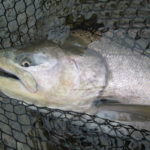
Take a look at the below listing you will not want to miss this rare Alaska Peninsula king fishing chance!
Alaska Peninsula Steelhead
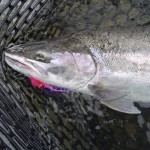
Steelhead fishing is on of the most fun fishing to be had in fresh water. Come fishing the Sandy River Lodge with us and enjoy the adventure and the great steelhead fishing the Alaska Peninsula offers.
Alaska Peninsula Silver Salmon
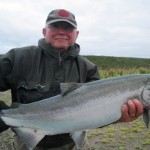
COHO NIRVANA ON THE ALASKA PENINSULA
For a die-hard anadromous salmonid angler, the endless conga line of chrome-sided silver salmon pouring upriver past me as I stood knee deep in the current was a truly astonishing, awe-inspiring sight.
Targeting a group of twenty-plus coho that were approaching in the clear shallow water, I cast towards the lead fish. I swung my concoction of bright feathers and shiny tinsel on a tight line across the current, adding false strips so as to impart a tantalizing action to my offering. A pod of five salmon immediately turned and gave chase, and a stout 13-pound hook-nosed buck beat his companions, creating a huge surface boil as he savagely clamped his jaws onto the bright pink fly. I swept my Spey rod in a low arc towards the near bank to set the hook – and he responded by immediately blasting across and down the river, followed by yards of backing that rapidly disappeared from the screaming Hardy reel.
I tried to palm the rim of the big Duchess to slow the vanishing coho, but jerked my hand away as the friction from the click drag caused the reel to become too hot to touch. The faint odor of burning lubricant wafted towards my nose, and the whirring handle was rapping my knuckles, rat-a-tat sound accompanying the howl from the reel’s double click pawls.
The fish finally stopped far below me, and he wallowed and violently shook his head as I tried to hold him in the swift current, with my long Winston rod throbbing and taut line humming like a guitar string in the heavy flow. Our détente lasted only a few seconds as the big buck then decided that his best chance to escape his tormentor was to continue back to vast expanse of the Bering Sea. Once again the Hardy sounded out in protest, and the rattling howl combined with sound of whacking bones resumed, as I began to wonder if I could ever land this out-of-control, crazed salmon…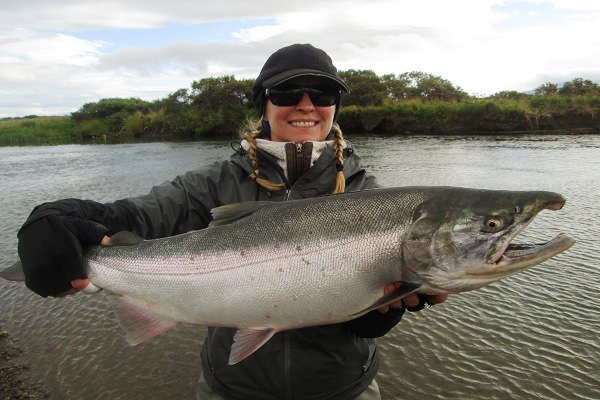
I struggled towards the shore and stumbled through the shallows along the gravel bar towards the vanishing coho, but found myself suddenly confronted by a steep drop-off with water beyond that was too deep to wade through. As I was evaluating my remaining options, the fish suddenly veered towards an enormous jam of downed trees in an instinctive bid for freedom. Foregoing caution, I performed a Spey harkari, bending my rod all the way to the cork grip, free hand wrapped around the Duchess in a desperate attempt at preventing the buck from ensnaring himself in the underwater branches. The maximum pressure finally succeeded in stopping the fish only a few feet from the submerged tangle; for long seconds, neither of us gave any quarter, as the uncertain outcome of our battle hung in the afternoon sunlight that shimmered the river’s surface.
Finally, the buck began to weaken, and I switched to a low, sideways rod angle that added a bit of slack line. I ceased my pulling, and I was vastly relieved when the fish responded by slowly swimming towards me and away from the hazards. Nearly 200 yards and a swift current separated me from my prize, and so I put the tip of the rod underwater, pointed it at the fish, and commenced to steadily reel the big Hardy. By keeping all of the line in the water, it bellied below the fish, which then induced him to swim opposite to the direction of pressure i.e. upstream against the current. This technique – affectionately known as “Walking the Dog”, and shown to me by my guide and good friend Trevor – can be very effective for landing fish that have run far downstream, in situations when you’re unable to give chase…
Following a series of yet more cross-stream dashes that took back much of the line that I had so painstakingly won, the coho salmon was finally slid into the shallows, a chrome torpedo wallowing at my feet as he surrendered to the boron, graphite, and nylon. I marveled at his enormous blimp-like girth, his broad broom-shaped tail, and the quivering muscles that were humped well above and behind his gator-sized head. A coterie of parasitic sea lice copepods hung down near the ventral fin, their dark color and long tails indicating that this salmon had been in the river for mere hours – hence the sheer strength and amazing stamina displayed in his bid for freedom. Using care to avoid sharp teeth that would be subsequently used in spawning ground battles with rivals, I removed the barbless stinger hook, and held him upright facing into the current. Strength returning, he bid adieu with a sweeping splash to resume his final sojourn.
It was the first week of September on the remote Alaska Peninsula, and our group of avid coho salmon anglers had reunited to pursue anadromous chrome at one of the very best remaining spots on the planet to encounter vast numbers of Oncorhynchus kisutch that could be caught with Spey tackle and swinging flies.
This was my seventh trip to the Sapsuk River and to APICDA’s riverside camp, located just west of the Aleut village of Nelson Lagoon. We had traveled aboard an ultra-modern, Swiss-built Pilatus aircraft (chartered from Alaska Air Transit) and our 500-odd mile flight from Merrill Field in Anchorage had taken us over snow-capped volcanoes that soared into the skies along the west side of Cook Inlet and formed the backbone of the narrow Peninsula. Vast stretches of rolling tundra, pocked with countless ponds and crisscrossed by waterways both large and small, appeared below us, mixed with occasional glimpses of lonely beaches upon which the Bering Sea expended its fury during fierce storms.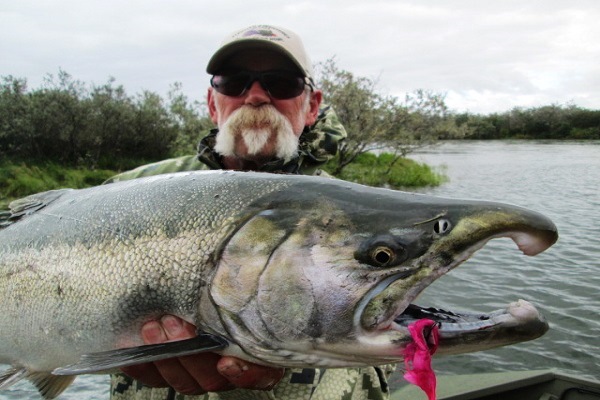
Landing on the gravel airstrip in Nelson Lagoon, our expert pilot – a former Navy flier who had made hundreds of landings aboard an aircraft carrier – touched done softly. Clouds of dust billowed behind us, as we taxied towards the greeting crew. Waiting for us were wonderful folks Merle, Sharon, and Kenny, who were lifelong residents of this tiny Alaska Native community. Our gear was quickly offloaded, and as the previous week’s anglers boarded the plane for their return back to Anchorage, they confirmed that the main run of coho salmon had indeed arrived in the river.
We enjoyed the comfort of Sharon and Kenny’s house, and were treated to their wonderful hospitality and a delicious steak dinner as we waited for the rising tide. The sun began to drop towards the horizon when peak flood filled the Lagoon, and Merle piloted the big aluminum vessel across the wind-driven chop towards the mouth of the Sapsuk, where we were met by the smaller jet-powered sleds brought downriver by the guides. I waved as I saw my dear friends Mike and Trevor approach us, and rounds of fist bumps and hugs followed our reunion with the awesome camp staff. We piled luggage, rod cases, and mounds of provisions into the boats, then fired up the Yamaha outboards for the last leg up to camp, arriving at dusk to be greeted by our delightful cook Kathy.
After hastily stowing my gear in our assigned WeatherPort tent, I hurried down to the river to make a few casts in the remaining light. My first throw resulted in a bright 9-pound hen that somersaulted repeatedly across the water, with the 7- weight Winston BIII 13’3” Spey rod bucking and 4” Hardy Bougle reel howling in response. I managed to hook four and land three more cohos before the descending darkness reminded me to yield the river to the nocturnal bruins (whose large paw prints marked their passage on the very same trails that we anglers use). Back at camp, I re-secured the protective electric fence, and took a hot shower before turning in.
Early the next morning, my alarm rang just before the camp generator fired up. Grogginess dispelled via another shower, I sat down with Diana, Jerry, Mike, Mark, Kirk, and Charlie to a delicious and hearty breakfast in the warm dining tent. This trip, I had vowed to change my reputation as being the last person who showed up down at the boats (!), and I thus hurriedly finalized my gear preparation post-repast, rigging two more Winston Spey rods, and stowing additional tackle items inside my waterproof Orvis sling pack.
Mike and Trevor were waiting for us at the boat landing, and we cast off at first light. Due to a series of early fall rains, the water levels were higher this year, and both guides opted to take us upriver where the silver salmon were more concentrated. We motored past typically productive spots such as the Mojo and Cabin runs, with the other group of Mike C, Mark, Diana, and Jerry (guided by Mike F) electing to stop at the Weir Pool; our guide Trevor decided to start Charlie, Kirk, and I further above.
Through polarized sunglasses, we were delighted to see hundreds of bright cohos holding at every deep run upstream of camp. It took only 10 minutes to reach our first fishing spot, and our initial casts resulted in hookups with chromers that leapt high above the water, bending our rods and yanking line against tight drags. Excited whooping, broad grins, and gleeful high-fives ensued between all of us – how wonderful it was to be back in Coho Nirvana!
Coho salmon (Oncorhynchus kisutch) — also known as silvers — are eagerly sought after by Alaska fishers because of their widespread distribution and vigorous fighting abilities (which includes amazing leaps and powerful runs). Marine anglers catch thousands of cohos in the ocean and estuaries during the summer months, while others target them in freshwater, as they ascend rivers to spawn during autumn.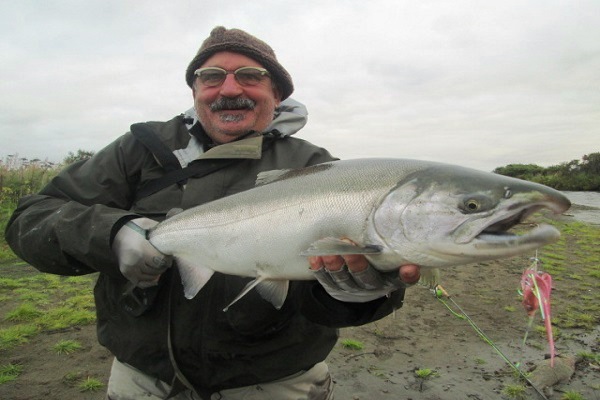
The Alaska Peninsula’s silver salmon runs occur later than most others, and these fish have additional weeks of ocean feeding before commencing their final journey. Thus, compared to other systems with earlier runs, the average size of the adult cohos caught here can be considerably larger – many fish are over 10 pounds, and our Sapsuk guide Mike weighs silvers that exceed 16 pounds every season.
As anyone who has fished for freshwater cohos can tell you, these fish can become dour once the initial action on eager fish is concluded – leaving anglers frustrated while watching dozens of unwilling salmon mill about, ignoring all offerings. However, the sheer numbers of silvers spread out over many miles of river on the Sapsuk – and lack of competition, as there are only two operators here — means that you merely move to the next un-fished spot to find fresh biters and resume the hot angling (!).
Having sampled waters throughout Alaska that range from heavily-frequented to remote/lightly fished, the coho angling success on the Sapsuk exceeds anywhere else that I’ve visited. Coupled with the opportunity to cast light tackle in a moderate-sized river, along with minimal angling pressure, and over hundreds of fresh, out-sized silvers that arrive each day, the Sapsuk offers an unparalleled opportunity for both seasoned swing fishing experts and novices to satiate desires of hooking sea-run chrome salmonids, until you’re completely exhausted…
Just how good is the coho angling on the Sapsuk River? Here are my tallies from the two most recent years:
- 2016
- First trip: 646 cohos hooked during 6 days, 383 landed on Spey gear/swinging flies (including a day with 112 fish landed)
- Second trip: 355 cohos landed on Spey gear/swinging flies during 4 days (including a day with 89 fish landed); there was 1 day of high and muddy water plus another one that we spent searching for steelhead in the upper reaches
- 2017: 417 cohos hooked during 5 days, with at least 267 landed (including a day with 108 hooked and 86 landed on Spey gear/swinging flies)
*Note: APICDA’s camp is located in the heart of the best water, and each day’s angling begins within minutes of leaving the boat landing, and continues until 4:45pm when the guides return – plus intrepid folks can keep fishing (sans Mike and Trevor) before and after dinner too. Perhaps there’s a river somewhere in Alaska where you can find equivalent angling for silver salmon that’s combined with comfortable accommodations and awesome service (?) – if so, please tell me about another such Coho Nirvana!
The Weir Pool is located just a few minutes by jet boat upstream of the Sapsuk Camp, and this amazing spot was jammed with thousands of cohos during our visit. Each pass through with our swinging flies yielded dozens of fierce grabs, followed by swift dashing runs, frequent aerial displays, and grinning anglers. There were so many fish present that the action here was non-stop, all day; one merely had to change to a different color and/or pattern to keep hooking fresh silvers.
While any large flashy fly would catch cohos, we have found that one tied with a heavy, chrome cone head (3/8” size) and long wiggling tail (3”-4”) seemed to be the most effective for Sapsuk fish. I had copied one of Mark’s patterns, which he used with deadly effect on these silvers: it was similar to a Dolly Llama, but was made with webby saddle hackles (instead of a bunny strip), and sported a marabou collar plus extra pieces of long tinsel. I revised Mark’s original name for it — the “Sapsuk Chicken” — into “Coho Pollo”, and found that all-pink, black and chartreuse, purple, and white/chartreuse were effective colors; my favorite was tied with a cerise marabou collar and a purple saddle hackle tail (nicknamed “The Purple People Eater” or PPE). Each fly was rigged with an extended trailer loop of stiff braided line, to which a #1 or #1/0 (my preference) octopus style hook was attached “stinger-style”.
Top water patterns also were effective, especially during the gray of early morning (or when clouds subdued the overhead light). As anyone who has used these flies on cohos, it’s truly awesome to watch the surface action as the fish stalks, then grabs your faux offering. Using a low-profile “gurgler” pattern (with a foam strip back) typically produces more solid takes, compared to poppers made with deer hair or Styrofoam (as these bulkier flies seem to bounce off the fish’s snouts).
During our daily trips above the Weir Pool, we had seen a section of river with oodles of coho jammed up along the far bank. This particular run had been untouched, due to the deep, soft mud on the nearside entry spot which mired and discouraged wading anglers. I finally decided that these particular silvers couldn’t be ignored any longer, and I convinced Trevor to drop me off here before he anchored his boat at the next downstream corner.
A stout stick helped me to traverse the clinging muck along the bank, and to my pleasant surprise, the bottom grew firm (albeit deeper) as I waded out within casting distance of the constantly rolling fish. Although my first throw fell short of the far bank, I let the gaudy concoction of shiny tinsel, brightly colored feathers, and tempered steel swing across the river, and saw a wake follow the fly before a big boil, strong tug, and throbbing rod indicated that the salmon had taken it. Flashes of chrome emanated through the water as the minty hen shook her head back and forth, and she blasted off in a sizzling run towards Trevor’s distant boat, grey hounding atop the surface in a dazzling display of power and grace. The howl of the Hardy Bougle, combined with the deeply bent Winston Spey and ripping noise of my backing tearing through the current, was truly delightful.
I continued to work my way down the fish-packed run and managed to hook dozens of silvers, with multiple cohos eagerly chasing my Pollo on every swing, resulting in scores of wildly leaping and dashing, chrome-sided salmon. Until the hot action ceased an hour and a half later, I blissfully forgot about the chilly water and body aches, until I climbed back aboard Trevor’s jet sled with icy feet, sore arms serving as a reminder of the astonishing angling I had just experienced.
To those anglers who “poo-poo” fishing for supposedly “lowly” cohos: your lack of interest in the vicious strikes, astonishing aerial acrobatics, and powerful dashing runs of these wonderful anadromous salmonids means that there’ll be more of them for me to catch. Even after coming to Sapsuk for a number of years, and hooking thousands of silvers here, I never get jaded — nor take for granted how amazing and special this place is… if you unwisely decide to pass on this marvelous fishery, you have my deepest sympathy for missing out!
Despite experiencing a long and fulfilling day hooking dozens of powerful salmon, a few incurably addicted anglers always seem to desire yet more action. The Sapsuk Camp has an easy remedy for such afflictions, as there is superb swinging water located at, below, and above this facility.
I (and my fellow addicts Mark and Charlie) decided to satisfy cravings for additional yanks by chrome salmonids every evening. Due to the higher river levels, the cohos were holding in softer water, and I quickly learned that allowing the fly to swing all the way into the shallows below me, then letting it dangle for a bit, would result in hard takes (albeit I wasn’t able to successfully pin many of these “hang down” biters, due to my over-eagerness in hook-setting).
One holding lie — tucked against a cut bank with an impenetrable mass of tree branches hanging a few inches above the surface – provided an interesting angling challenge. I finally solved this fishy riddle, which required a stealthy approach (keeping a low profile so as to avoid spooking the fish) and patient waiting to succeed.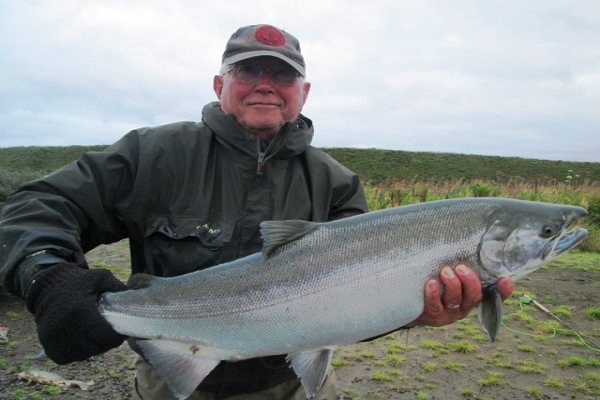
Picture this: Yours Truly hiding in the tall grass next to the bank, with the tip of my Spey rod sticking out over the water. I’m keeping the Pollo above the surface, with several feet of coiled line held in my hand, ready to drop it front of a coho when the opportunity presents itself. The group of bright silvers holding beneath the tree branches begins to bump each other, and a large buck with broad shoulders peels away from the bunched up fish, seemingly annoyed… he then re-positions himself a yard downstream of my rod, whereupon I release the fly, then gently wiggle it enticingly in front of him… his jaws yawn open as he swims forward to eat my pattern… I lift the rod, and the surprised fish shakes his head violently, then tears off across the swift current, while I arise with numb legs and attempt to clumsily follow…
Earlier in the week, as I stood in the shallows along a gravel bar near camp, I was pleasantly surprised to see the PPE Pollo disappear in a massive boil while it dangled a few yards beyond my Spey rod. Somehow — and in spite of being completely unprepared — I managed to remain attached to this 11-pound chrome-sided hen, gratefully landing her after a spirited battle replete with body twisting leaps and blasting runs. Closer inspection of this unlikely spot revealed a short and narrow slot with soft water and just enough depth for salmon to rest in, after negotiating the long, swift rapids below. I thenceforth made sure to swing my fly through this hidden lie every evening, which produced at least one jarring strike each time.
Quite a few of the fish I hooked in this particular spot elected to bid adios muy pronto by immediately blasting back down the long rapid that they had so strenuously negotiated. This created a curious mixture of exhilaration and despair as I tried to unsuccessfully slow the departing cohos with my palm held against the chattering Hardy reel (and getting my knuckles badly bruised instead). The backing melted away as the sprinting silvers emptied the spool, saluting me far downstream with their tails raised high (aka the piscine version of an outstretched middle finger). While I did manage to coax a number of these hooked fish back up to me by employing Trevor’s “Walk The Dog” technique, many of them gained their freedom after the hook pulled out (likely due to excessive pressure from fighting against heavy current).
My last two days on the Sapsuk passed in a blur of Spey casts, protesting reels, and acrobatic salmon dashing about. All seven of us ended up at the Weir Pool during the final afternoon, and we were constantly hooked up as yet more fresh, sea-lice adorned cohos continued to pour into the run. Diana fished off the stern of Mike’s parked boat, and caught fish after fish from this comfy casting platform without having to get her waders wet, while her husband Jerry spanked the silvers with his “Coho Death Star” fly/spinner combination. Mike and Mark also had their Spey rods constantly bent by grabby cohos that tore across the pool like wild demons. Meanwhile, our conga line of Kirk, Charlie, and moi fished the lower end, working downstream in unison, and our triple-headers were announced by gleeful shouts of “Fish On!” and “Coho!”. For three hours straight, I tried to make a swing without a grab, but failed to do so – there were so many eager biters. Nearly all of the fish were dime bright, and there were lots of double-digit sized silvers landed by everyone.
That evening, we took the opportunity to compliment our wonderful camp staff for all of their dedicated efforts during the week. I gave Kathy jars of homemade wild raspberry jam (which she was delighted to receive), and I augmented Trevor’s après-guiding beverage supplies (he was also pleased with the gifts of a hoodie and aluminum fishing pliers). We knew that our head guide Mike would turn 50 in a couple of weeks, and he had a broad grin as I presented him with a 9-weight Spey rod (a classic Sage “brownie”) for his birthday, which would be put to good use during next year’s chinook salmon season on the Sapsuk. Charlie added a beautiful filet knife (custom made by an Alaska craftsman), and all of us laughed at the pile of black balloons strewn about the floor of the dining tent, in honor of Mike’s half-century milestone.
During the angling session that last evening, my penultimate silver salmon turned out to be the largest, strongest, and fiercest fish of all the ones that I had caught this trip. The giant buck grabbed at the top of Silver Tree, where he smashed my PPE at the end of the swing mere feet from the bank. I was (fortunately) using the heaviest Spey rod in my arsenal – a Winston BIII 13.5’ 8-weight — which immediately doubled over from the vicious strike, and it throbbed as the angry fish strove in vain to shake the annoying hook from his jaws with shakes of his massive head. Failing to free himself, he then turned into the heavy current, and powered toward the far bank. The hair-raising run ended in a series of yard-high, aerial cartwheels followed by stupendous crashes back into the flows, before he bolted downriver in an unstoppable run. The Hardy screeched noisily as he tore off, causing the handle to spin wildly as the thin backing whipped through the rod guides. I could not follow the fish because it was too dangerous for me to wade beyond the outstretched alder branches; I would have been instantly swept off my feet into the swift current, and I thus had no choice but to hang on and hope that he wouldn’t spool me.
Senor Coho Grande finally stopped his mad headlong dash, and held amidst the boulders far below me. In response to my predicament, I directed a string of choice phrases at the fish, finally deciding that a Hail Mary maneuver was my only remaining option. I stripped a few yards of the severely depleted line and tossed it out with a flick of the rod tip. Although the current quickly pulled it tight again, I hoped that there had been sufficient time for the heavy Skagit head to belly below the fish and turn him back towards me. The fishing gods smiled upon me as my desperate tactic worked, and I felt an easing of tension as the mighty salmon powered steadily upstream. I lowered the Spey rod into the water, reeling slowly to take up the slack while not alarming him, and in such fashion, I managed to retrieve most of the running line — only to have the fish dash back downriver when he realized my feint. The chatter from the Hardy grew to a banshee howl as he blitzed towards the safety of the rapids below, while I could do naught but hang onto the bucking rod with grim determination.
I was about to concede defeat when, for some odd and still unknown reason, the big buck suddenly stopped at the very lip of the distant tail-out below. Scarcely daring to believe my luck at this unexpected reversal of fortune, I did my best to avoid pressuring him and provoking yet another frantic response. Hey, I’m The Coho Whisperer I said to myself as the salmon succumbed to the now-familiar “Walking the Dog” technique. Yards of Dacron backing, then the RIO ConnectCore running line followed by the AirFlo Skagit head, were slowly wound back onto the spool until I glimpsed his enormous form flashing in the depths only a rod length away.
As the huge coho held in the current, I looked around me and suddenly realized that options for landing him were extremely limited: I saw that there was only a small indentation on the high bank with a tiny, steeply sloping beach a few yards upstream where I could possibly corral this fish. Fearing yet another bolting run, I nevertheless pushed him as much as I dared, using a combination of heavy nylon leader, straining boron/graphite rod, and quivering hand locked onto the aluminum reel. Time and time again, I would pull him downstream and towards the bank into the miniscule cove – but as soon as his ponderous belly would touch the gravel, he’d flex his powerful body and swim triumphantly back out into the river. This cycle repeated itself at least a dozen times before his stubborn strength finally ebbed, and he surrendered as I held him submerged against the narrow ledge. I marveled at the shiny scales atop his thick flank winking in the setting sunlight, and watched the massive hooked jaw working tiredly to pump water through his crimson gills, as he gazed at me with an upturned, pearlescent eye. The wrist in front of his tail was so big that it took both of my hands to grip him, as I knelt and gently nudged the fish a bit further out of the water using my wader-clad legs. I managed to snap two photos before the stinger hook slid out of his jaw, whereupon he took advantage of his sudden freedom to re-right himself, then swim between my spread legs and completely soak me with an indignant departing splash from his broad tail.
The next morning, I finished packing my gear, then ate one last yummy breakfast before boarding the boats for the return trip back to the village. After bidding farewell to our camp crew, we spent a few delightful hours again at Sharon and Kenny’s home, then flew back to Anchorage via the swift Pilatus (stopping briefly in Dillingham to re-fuel). From my lofty vantage, I marveled at the vast waters of Illiamna Lake sparkling in the sun, and gazed longingly at Aniakchak volcano beneath the us, vowing to someday float through the gorge carved by the river exiting from its lake-filled crater. The broad sand flats filled with delicious razor clams on the west side of Cook Inlet beckoned to me, and I felt an urge to ask our pilot to set down next to one of those clear water systems flowing into the sea… surely, there must be anadromous chrome in them worthy of seeking with a Spey rod and swinging fly…
Copyright 2018 © GF Spey
Permission to use this article and/or photos can be obtained in writing from:
Glenn Chen, GF Spey
PO Box 2198, Homer AK 99603
homerpisces@yahoo.com
Great Fishing Opportunity
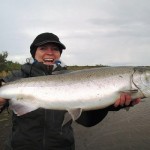
Here is a great opportunity for someone to come enjoy the wilds of the Alaska Peninsula and experience some of the best silver salmon fishing in the world. Please take a look below and give us a call if you have any questions or would like to book this great trip!
Beat Systems
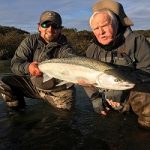
Even in Alaska fly fishing destinations can seem busy at times. That said, it is all relative. Some feel that a beat system can help spread people out and have a schedule of areas for people to fish. This type of approach can be embraced by some and criticized by others.
There are many rivers around the world that operate on beat systems. I imagine there are a few different ways to scale a beat system to a specific water body.
One way a beat system can be scaled is to use fairly simple math. If a river has 700 Salmon caught over a season it allows 700 rod days a year. The season for sea run fish species is typically 90 days so a river with 700 salmon caught every year would allow 7 rods to fish the river on a daily bases.
This makes the fishing in some areas of the world more exclusive and it also helps both protect the anglers right to privacy while fishing as well as protecting the stocks from too much pressure.
Fishing a 15 mile area that has 3 beats, each rod then has 5 miles of fishing area.
I can see arguments pro and con for a beat system. At a glance it seems more enticing to me to fish a river with less people and fewer boats running around looking for a place to fish. Similarly, would you rather wait in a line with 10 people or 100 people….
Setting The Hook

It is just about Spring in Alaska, this is the time many of us start to think about swinging flies for the wild king salmon of the Alaska Peninsula. The Alaska Peninsula is host to arguably the best king salmon runs in the world.
It goes without saying it can be difficult at times to hook and land these large sea run salmon. That is way it is very important to be alert and very much aware of where you are fishing and where your fly is in relation to you. Below are a few simple things to think about that may help you land a few more fish this season.
When swinging flies for salmon, in many cases it is more effective to successfully hook the fish while setting your rod tip to the side in the direction of the swing (as opposed to straight up). Some people say set toward the bank, which in most cases can be true, however in some cases you may be fishing mid river…. so simply set in the direction of your flies swing.’
The primary reasons for setting the hook with a low motion in the direction of the swing are:
- There is minimal slack in your line when setting the hook
- By setting the hook with an upward direction there tends to be a pause in the flys swing which can result in a missed or weak hook sets or or scaring the fish away.
- Yes, fish can be scared away… if the hook set just simply doesn’t happen, it is not uncommon for the fish to return to the fly on a following drift giving you another chance.
By patiently letting the fish take the fly and setting with a low rod tip in the direction of the swing you are likely to both play and land more fish.
Below is a video which shows some nice hook sets along with a few of the ones that got away!
[embedyt] https://www.youtube.com/watch?v=q2X2w8K2PcM[/embedyt]
Alaska Salmon Fishing Lodge
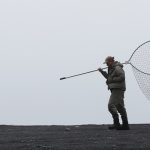
THE MIGHTY KING SALMON OF THE ALASKA PENINSULA
As the big fly swung next to the bank, I felt a soft pluck, followed by a series of increasingly urgent tugs before the tip of my Spey rod was pulled down in a solid arc towards the water’s surface.
Rousted from my early morning reverie, and with mental circuits dulled by too many pre-dawn risings, my response to the take was atypically delayed. This turned out to be a good thing, as lack of sleep had intervened to prevent me from yanking the fly away from the fish, before it could fully engulf the faux concoction of shiny tinsel and wiggly feathers, wound around tempered steel. Throbbing headshakes were now sending stupendous jolts up the taut line, and the klaxons suddenly sounded off in my head – set the hook now, you darn fool!
The resulting reaction from the big chinook that had grabbed the six-inch long, blue and black Stinger Prawn was nothing short of astonishing. There was a momentary stillness that hung in the morning vapor – and then all hell broke loose.
The big chinook bulldozed across the river, with the trailing line hissing audibly as the nylon running line cut through the current. Reaching the far side, she suddenly decided that her best escape from this unanticipated torment lay in a return back to the sea. The chrome hen instantly set off on a blistering downstream run, with dorsal fin and half of her broad body out of the water, muscling against the tight drag in an amazing display of pure power; my line instantly melted off the reel as if it had been set on free spool. A giant rooster tail of spraying water, accompanied by sounds of ripping Dacron backing slicing through the water, followed the swiftly vanishing fish.
All I could do was stand there, gripping the bucking rod with mouth agape, momentarily forgetting to breathe. My line hand absently drifted down to the frame of my wildly spinning fly reel, and I suddenly jerked it back in dismay, as the friction-generated heat from the drag scorched me like a red-hot coal.
With over 200 yards of line out in the river, the fish finally decided to stop at the very end of the pool, just before the current broke into the faster water below. The long rod was deeply bent all the way to the grip, and each of her ponderous head shakes generated extreme anxiety about the hook coming undone. A standoff ensued, during which neither of us relaxed nor gave quarter as the stretched line hummed in the current. For a while, I was beset by despairing thoughts of losing this salmon, until the heavy pressure from my tackle finally began to coax her back upstream, one slow reel crank at a time.
During the long minutes that followed, I gained but then lost line repeatedly, as the struggle continued; at one point in the fight, the chinook made another wild, unstoppable dash back down to the tailout — a display of defiant determination pitted against modern angling technology. Far below me, she rose to the surface, her twisting body and thrashing tail throwing fountains that glinted in the morning light – an awe-inspiring, magnificent sight indeed.
Eventually, my running line and then the Skagit head emerged and were wound back onto the spool, as the salmon’s strength slowly ebbed against the inexorable pull of boron, graphite, and nylon. I hollered to our guide, who came sprinting along the bank towards me to assist with the final touché. Joe assumed the statue-like stance of a patient heron, peering through his polarized glasses and seeking just the right opportunity to slip the net beneath my prize. Several times, I successfully steered the hen’s head towards the waiting mesh and over the net rim — only to watch the chinook flex her powerful tail and dash away. She then made one final, half-hearted run a few yards downstream, floated to the surface, and opened her mouth – whereupon she shook the hook free, leaving us with naught but exasperated stares.
This was my second week of chasing chinook salmon on the Alaska Peninsula, during an extended fly fishing sojourn that took place in early summer of 2017. I had just completed an incredible angling session for sea-bright kings on the nearby Sandy River, and was eagerly looking forward to the possibility of battling yet more chromers on the Sapsuk River.
The ultra-modern, state-of-the-art Pilatus charter aircraft made the short flight from the Sandy to Nelson Lagoon in swift fashion, and as we landed on the gravel airstrip, I saw welcome faces awaiting my arrival. The greeting crew included Kenny, Sharon, and Merle, who were lifelong Alaska Native residents of this small Aleut village; big smiles and hearty handshakes were exchanged with these wonderful folks, whom I had become friends with over my numerous visits to this remote community (located 500 plus miles west of Anchorage).
Through the plane’s window, I had spied my long-time Alaska fishing companion Charlie standing at the edge of the runway; his enormous grin relayed the success he’d had during the prior week. I strolled towards him and the small knot of departing anglers to quiz them about river conditions, and also met the two fishers who would be heading up to camp with me: my California friend and Sapsuk regular Mark, and Michael from the UK, both of whom had arrived on an earlier flight from Anchorage. As the plane was unloaded and re-packed, Charlie regaled us with tales of the big salmon he’d hooked and fought – the main run had arrived, and we would be casting over fresh kings during the next 6 days.
With the tide nearing flood stage in the Lagoon, we quickly transferred our gear onto the boat, launched her, and then sped across the chop with Merle at the helm. At the mouth of the river, camp manager/head guide Mike was waiting there to take us upriver to the camp. I greeted my dear friend with a bear hug, and, after piling mounds of fresh provisions, rod cases, and luggage into his jet sled, he promptly fired up the Yamaha outboard and we roared upriver at full throttle for the final leg of our journey.
As we approached the camp’s boat landing, I saw the familiar face of our delightful cook Kathy standing atop the uppermost platform. I enthusiastically returned her wave and big smile, then saw someone sweep past her and bound nimbly down the steps towards us. The colorful blur morphed into a grinning, bearded man wearing Terminator-style shades; I turned to Mike, who laughingly introduced me to his new guide. I managed to grab Joe’s hand for a brief handshake between his swift trips carrying the boxes and bags, watching in astonishment as he hauled the weighty items up the steep stairs with alacrity and exuberant bursts of youthful energy.
Having fished at the Sapsuk for autumn coho salmon (Oncorhynchus kisutch) and fall steelhead trout (Oncorhynchus mykiss) during prior seasons, I was eager to test my skills against the larger and more spirited chinook (Oncorhynchus tschwytscha). On the Alaska Peninsula, these fish return to their natal rivers during June and July, ascending to upstream spawning areas and completing their life cycle sometime in mid to late summer. A typical AP king weighs between 18 to 25 pounds, and I had heard prior tales about Sapsuk anglers hooking fish approaching 40 pounds. These fish were mighty adversaries that were renowned for their awe-inspiring power and incredible stamina, and catching one requires long hours of dedicated effort, and waging pitched battles against formidable strength that was slow to yield. Landing half of the chinook you hooked was considered exceptional, with many anglers managing to attain far lower percentages; little wonder, then, that king salmon were atop the pinnacle of Pacific salmon species pursued by the international coterie of anadromous salmonid anglers.
Heavy gear is necessary to successfully subdue these ultra-strong fish, which fight like demons incarnate after feeling the sting of a hook. I was equipped with Winston BIII Spey rods (including a 15’ 9-weight and a 13.5’ 8-weight) and high quality disc drag reels (Loop Evotec and Orvis Hydros; I left my classic Hardys at home, knowing full well that these click-pawl reels would be inadequate for handling the powerful kings). Skagit heads attached to floating running lines, along with an array of sink tips, stout leaders, and an assortment of large attractor flies rounded out my tackle arsenal.
The first day of angling began with the alarm sounding off at 0300, followed by breakfast thirty minutes later, and departure at the onset of first light. Besides Mark, Michael, and I, our camp was fully occupied and included three French anglers, who had booked two consecutive weeks; each trio rotated between the two guides, allowing us to change fishing beats every day.
We drew the upper water and stopped first at the Cabin Corner, a deep pool formed via current scour against a hard clay bank. Casting in the gathering light, I was rewarded with a grab on a chartreuse Bjorn Stinger Prawn during my third swing. I waited for what seemed like excruciatingly long moments as the gentle tugs morphed into steady pulls, culminating in a deep rod arc before I finally jabbed the hook home with a simultaneous sharp yank on the line and swift lifting of the tip. A series of violent headshakes, followed by the hair-raising sensation of being attached to an unstoppable moon rocket, ensued as the big buck powered across the hole and sought safety amidst the boulders lying in the tailout. I barely managed to turn him using maximum reel drag and pressure from the stout 9-weight; he eventually returned to the depths of the main pool, seesawing back and forth in the current as I constantly changed rod angles in an effort to confuse him and shorten the fight. Following a 10-plus minute tussle, Joe arrived with the net, and we successfully landed, then gently released, the 25-pound, mint-chrome male chinook.
After concerted efforts from all three anglers yielded no additional takes, we motored up to the Weir Pool, named for the sockeye salmon counting structure placed at its head by State fisheries managers (used to collect data for monitoring returns of this commercial important species). Hundreds of Chinook can be found here during the peak of the run, rolling on the surface and causing startling disturbances akin to catapulting giant stones into the flows. A reluctance to negotiate the sockeye weir, however, also slows their upstream passage; thus, kings tend hold here for lengthy periods after arriving, becoming darker and disinclined to strike; we therefore hoped that there would newer fish available to bend our rods.
Switching to my 8-weight Spey outfit, I worked the top of the hole with a series of concentric swings. After casting the heavy 9-weight for hours each day during the prior week, using the lighter rod was a welcome change, and provided some relief to my sore wrist and overly strained forearm… until that beserk henfish grabbed my blue and black Prawn and sprinted off downriver, as if all of the seals in the Bering Sea were chasing her…
I did manage to land my next hookup – an 18-pound, super bright buck – and all of us continued to hook chinook in the Weir Pool throughout the morning, along with an occasional sockeye that somehow managed to stuff the outsized fly into its smallish mouth. Strong gusts would frequently buffet us, and I strained to cast into the stiff headwinds, which at times caused my cast to pile into a tangled heap atop the water. Finally, after a couple of consecutive passes yielded no strikes, we decided to rest the hole, returning to the parked boat to eat Kathy’s tasty sandwiches and homemade cookies, and washed down our meals with strong coffee.
While enjoying our lunch, I spied wakes from newly arriving chinook entering the lower tailout, which provided sufficient enticement to resume our efforts post-repast. Swinging our flies past these fresh fish resulted in jarring, arm-wrenching strikes, and swift, greyhound-style dashes that emptied our reels. Sudden changes in direction by the salmon caused large loops of slack to form in our lines, and frantic retrieving to regain contact and a semblance of control were often futile. Joe sprinted up and down the length of the Weir Pool, netting one fish, then huffing away to land another. With the hot and heavy action, the afternoon sped by quickly, and we return back to camp, elated with our first day’s successes.
After a scrumptious roast pork dinner followed by key lime pie for dessert, I decided to check out a hole rumored to be a hotspot. Foot access to this particular DIY location, however, proved to be most challenging – I had to blaze a path through a an unbroken expanse of waist high grass, the dense vegetation constantly entangling my wader clad feet and causing me to stumble frequently on hidden obstacles. The ever-present winds had died down too, and my clumsy passage through the tall growth stirred up clouds of fierce mosquitos that slaked their bloodlust, as I tried in vain to swat them away.
I finally emerged onto the gravel bar and brushed off the last of the persistent ‘skeets, splashing cold water onto my skin to quell the burning itches caused by their feeding. Gazing out onto the river, the thrilling sight of several bright chinook rolling in unison quickly dispelled the torment that I had just endured. I waded in cautiously, working the Skagit head past my rod tip — and was instantly fast to a hot salmon. After beaching him, this initial king was followed by 6 more smash takes on successive casts, including one 28-pound fish that hotly pursued the Stinger Prawn across the surface with dorsal fin raised high above the water, before savagely clamping his jaws onto my fly… the torrid action continued for an hour as I worked my way to the end of the run, before things finally slowed.
The setting sun and dwindling light suddenly reminded me that my return trek would necessitate traversing through spots with limited visibility, coinciding with onset of crepuscular activities by the brown bears. The resident bruin – an exceptionally large boar nicknamed Yogi – ruled this section of river as his fiefdom, and I did not want to dispute his territorial claim, so I turned my back on the still-rolling kings and resumed my role as the moving feast for the nasty mini-vampires.
The next day arrived accompanied by overcast skies, receding flows, and increasing water clarity. Mike took us to the Mojo Hole, and I was soon rewarded with a massive, bear-trap strike. Vivid flashes of bright chrome rose from the depths as the huge buck twisted fiercely, straining mightily against the 9-weight Winston. We eventually landed him downstream of the parked jet sled, with Mike managing to just barely squeeze the big fish into the net. As he lay spent within the meshes, both of us marveled at the sight of his massive head, enormous girth, and giant spotted tail; the digital scale subsequently confirmed my weight estimate (35 pounds).
The Mojo Hole starts as a deep churning whirlpool at its head, makes a hard right turn along a high clay bank, and then runs straight for more than 75 yards before entering the Aquarium (aptly named for the dozens of fish that collect there in its gentle eddies, finning in plain sight). The lower portion of Mojo is bordered by thick alders and submerged trees along its deepest side; naturally, the salmon concentrate where these hazards are most dense, and so fishing this spot requires the utmost of Zen patience, as you attempt to work your pattern through the thicket of unseen snags. I ended up sacrificing three flies here, before I felt the unmistakable pull of another big king swimming away with my purple Prawn. The 20-pound buck remained deep during the fight, always pulling hard towards the safety of the sunken brush; I winced as I felt my leader scraping hard against underwater branches. Bending the rod in Spey harikari fashion, and locking the reel spool with my free hand, I applied pressure maximus to the fish. Fortunately, the Winston withstood the excessive force, and this king eventually swam free of the obstacles, allowing himself to be pulled into the shore, a silver torpedo finning tiredly at my feet.
As the week progressed, river levels continued to drop and clear, which further slowed the upstream movements of fresh chinook. We still managed to catch some chrome-sided fish on our initial passes through each pool, albeit the ratio of takes to casts declined noticeably. The longer waits between grabs had the unfortunate effect of increasing the frequency of blown hookups, as my responses grew ever more hair-trigger. I ended up having to take a serious chill break, after failing to provide the all-so-important delays that inevitably resulted in a maddening series of fruitless hook sets. Resuming my recitation of “God Save The Queen and Prince Charles! before striking eventually rewarded me with the satisfying sensation of a well-hooked chinook surging away, attached to my bucking rod and whirring reel.
I alternated between fishing the slower, deep pools where the adult kings were holding, and shallower runs that were dominated by smaller jack chinook. The latter are sexually mature, albeit precocious males that return to the river after a brief marine sojourn, and thus do not attain the full size achieved by the rest of their cohort (which will remain at sea for as long as five years). They serve a crucial role as a form of reproductive warranty, to ensure that the eggs of every female salmon arriving on the spawning grounds will be fertilized. These fish are eager biters, albeit shouts of initial glee often turn into disappointed grumbles when the angler realizes that he has hooked a “(insert expletive) jack”. As for me, I welcome their ferocity and stubborn tenacity, and I rarely forego an opportunity to swing a fly in front of such mini-kings, which can also provide a guilt-free and scrumptious meal upon successful capture (grilled with garlic, fresh dill, butter, and a squeeze of lemon juice atop the succulent filets).
During the last two days of our trip, the guides decided to focus fishing efforts on the lower beats, in the hopes of intercepting newly arrived kings that were more willing to bite. This proved to be a wise strategy – angling action improved, and we were subsequently able to hook (and sometimes land) a number of chrome-sided chinook with sea lice still attached to their bodies.
I recall an arm-wrenching strike from a bright 35-pound buck that ravenously attacked my pink Prawn, moments after it landed on the water; this crazed salmon strained my tackle and nerves to the utmost, reluctantly surrendering to the net only after a pitched battle, and dousing us with water upon release (employing the piscine version of a raised middle finger). A less glorious — and considerably more humbling — memory was of a big hen that slowly approached, then leisurely ingested my fly as it sank beneath coils of line stacked atop the water (the result of an errant cast thrown back at me by a gust of wind). As I watched her chewing on my offering in the clear water, I frantically stripped in slack before finally coming tight on this fish; she eventually earned her freedom right at the net, swatting the annoying Prawn loose from her jaw with a disdainful slap of her huge tail against the outstretched leader.
Folks who don’t desire to feel the brute strength, wild power, and uncontrollable panic associated with hooking a river king salmon that had been swimming in the boundless ocean a few hours earlier… should just stick to catching resident trout.
We spent our final day parked at the lowermost pools where upstream migrating kings first stopped to rest. This was an “ambush game” that was rewarded at periodic intervals between patient waiting, concerted casting efforts, and frequent fly changes. While I managed to land several hefty kings – including a 32-pound, copepod-decorated brute that immediately tore line off the reel after his ferocious grab – Mark was the hot stick, hooking up on consecutive passes after he switched to a heavier pattern (weighted with a large brass cone head) that enabled him to better entice the fish holding in the deeper parts of these runs.
Heading back to camp, I asked Mike drop me off at a favorite spot for a final session. I fished thoroughly and patiently through most of this pool, with nary a touch. Reaching the tailout, I let my Prawn fly dangle, swimming back and forth in the eddying current, in the hopes of enticing one last fish. My musings were pleasantly interrupted by a jolting strike – the enormous, chrome-sided buck thrashed violently at the surface, then cartwheeled end over end after feeling the offending hook. I managed to regain my wits and somehow remained attached to this out-of-control salmon, eventually parrying his wild runs until I was able to slide him into the gravel shallows. I placed my Winston Spey alongside, and noted that his snout extended nearly to the first stripper guide; back at camp, we used a tape to measure this length, and concluded that the fish’s weight was somewhere in the high 30’s.
The return to Nelson Lagoon proceeded in orderly fashion (which isn’t always the case – strong winds can result in big waves on the Lagoon, making it impassable; flight delays due to nasty weather occur frequently as well). I bid farewell to Kathy, Mike, and Joe; after days of wearing sunglasses and with the reflected sunlight browning the exposed parts of my face, I had acquired a vivid “raccoon mask” which evoked barely-concealed guffaws from the camp staff.
We were treated to clear skies during our flight back to Anchorage. The numerous streams and rivers flowing into the Bering Sea that passed beneath our wings sent their siren beckons to me… surely some of these must hold little-fished runs of chrome, anadromous salmonids (!).
My dreams of mounting a scientific expedition to document the distribution and abundance of chinook, coho, and steelhead along the Alaska Peninsula will need to become reality, someday .
Copyright © GF Spey (2018). All rights reserved.
